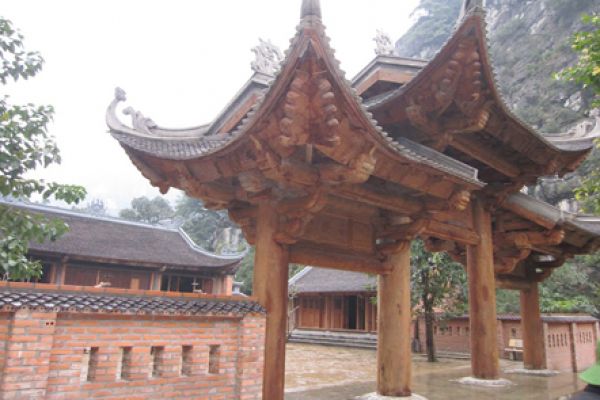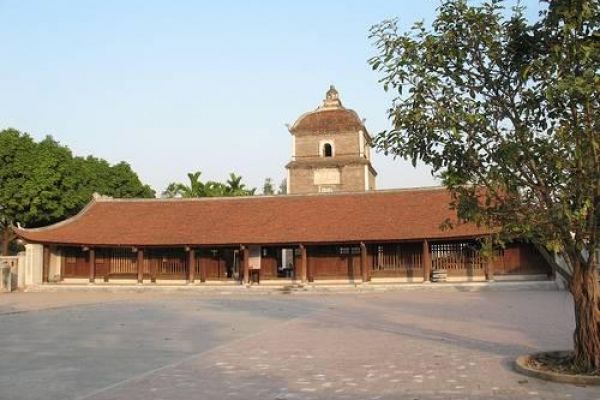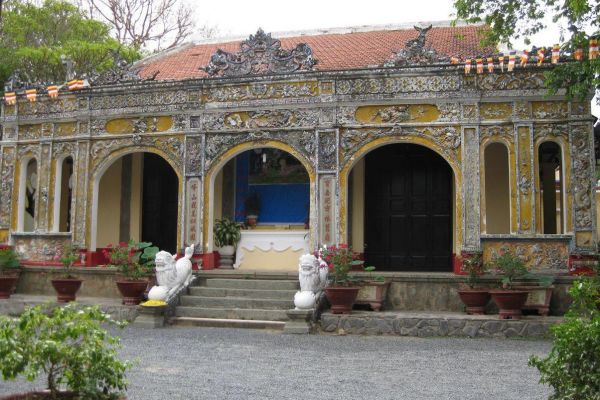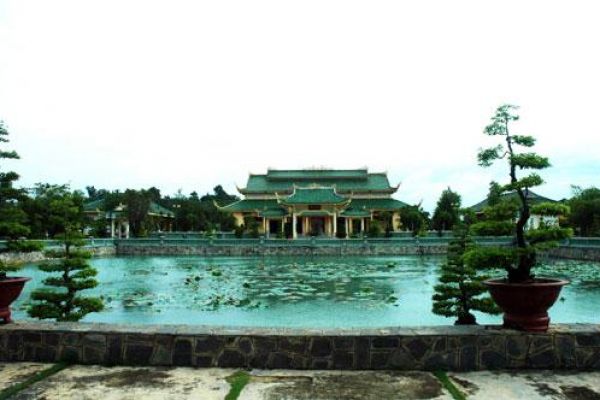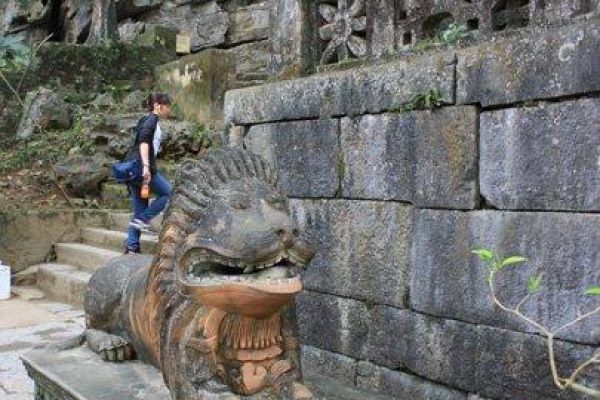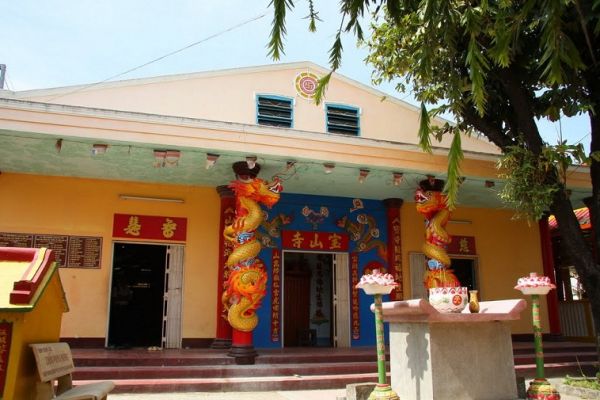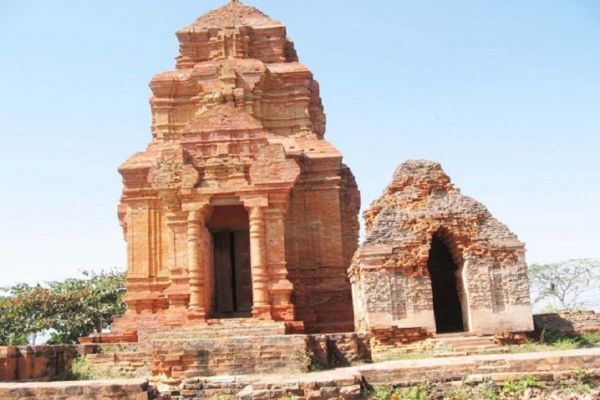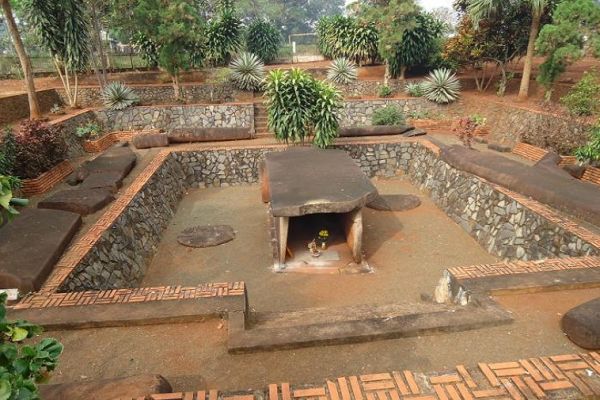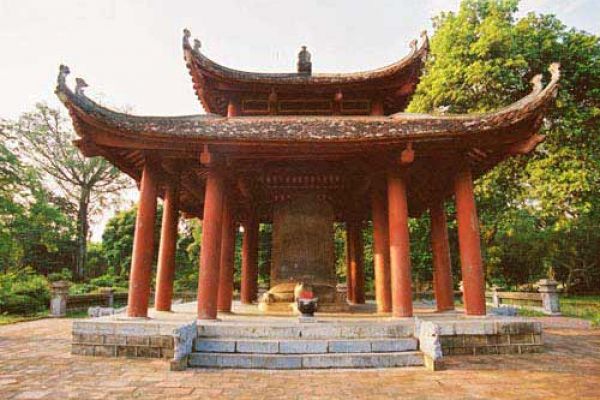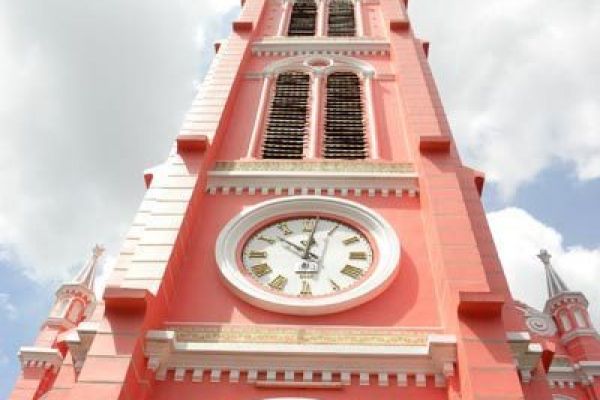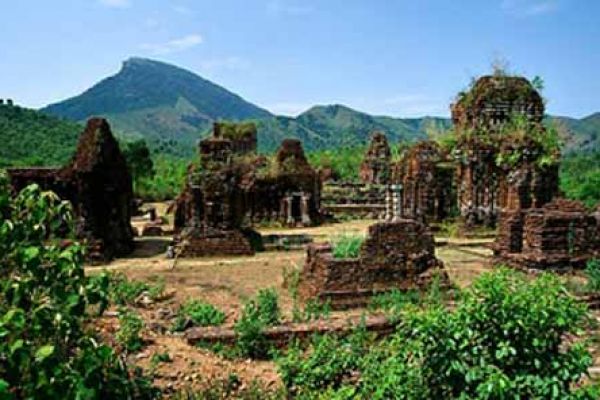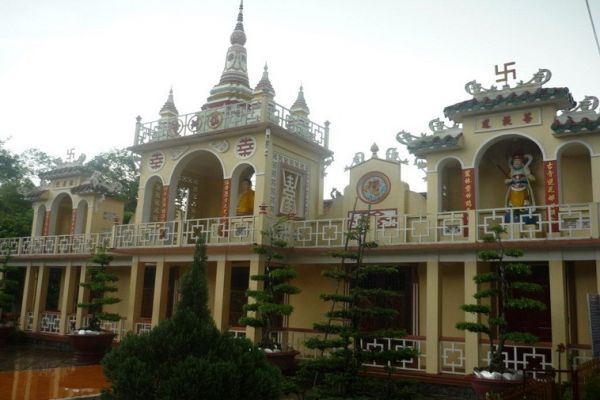The Huong Son Comples oi natural and cultural properties is situated on a limestone mountain range, some 60 kilometres southwest of the national capital of Fanoi. This mountain range was formed more than 200 million years ago. During its orogenetic movements, many scenic valleys' stream and caves were formed, adding attraction to the limestone mountains and natural forests.
The Huong Son Complex area is a natural habitat of many rare and values species of tropical fauna and flora as well as of primitive man in nort Vietnam.
A number of caves, such as Luon, Sap Bon, Sung Sam and Giac, archaeological sites belonging to the HOA BINE Culture dated back to over 10,000 years. In the far past, taking advantage of the local natural beauty, ancient Viets built a system of hundreds of Buddhist pagodas and temples in caves on mountain sides and abank streams, the most spectacular of which is the Huong Tich Cave which is also the most beautiful natural cave in the country. In this area is held annually the Huong Pagoda Festival which lasts for one month in spring with the participation of hundreds of thousands of people, both Vietnamese and foreigners.
The Huong Son Complex comprises a three groups of pagodes, temples and caves linked with one another by watervays (streams):
- The Huong Tich group accessible by the Yen Stream, including the Trinh Temple, the Son Thuy Huu Tinh Cave, the Hoi Bridge, the Thanh Son Pagoda, the Houng Dai Pagoda, the Thien Tru Pagoda; the Hinh Dong Pagoda, the Tien Pagoda, the Giai Oan Pagoda, the Cua Vong Temple and the Huong Tioh Cave.
- The Long Van group accessible by the Long Van Stream, including the Long Van Cave, the Tien Cave, the Ngubi Xua (Ancient Man) Cave, and the Cay Khe Pagoda.
- The Tuyet Pagoda Group aacessible by the Tuyet Stream, including the Mau Ha Temple, the Mau Thuong Temple, the Ca Pagoda, the Bao Dai Pagoda, the Tuyet Pagoda, the Am Pagoda and the Hong Son Cave .
Stop here and take a boat along the Yen Stream for about 3 km to Tro Wharf, from where the Huong Son Tourist Area is accessible. Huong Son Area is located in My Duc District, Ha Tay Province (old, now in Hanoi), approximately 70 km from Hanoi.
Huong Son Tourist Area covers an area of a thousand hectares and includes a complex of mountains, rivers and streams, villages, pagodas, and grottoes surrounded by the Huong Tich Mountain Range, north of the Truong Son Range.
This area is divided into three lines:
Huong Tich Line: It consists of Yen Stream, Trinh Temple, Hoi Bridge, Thanh Son and Huong Dai Pagoda, Thien Tru, Hinh Bong, Tien Pagoda, Giai Oan Pagoda, Cua Vong Temple, Huong Tich Grotto.
Yen Stream
This stream flows between two mountains for 3 km. However, sitting on the boat and enjoying the surrounding landscape, tourists may feel that this stream is endless. During the festive season, the stream is full of boats carrying pilgrims who have come to enjoy the landscape of Huong Son. Traveling along Yen Stream, tourist pass by landscapes, many of which are named according to their forms. On the left is Phoenix Mountain; there is also Doi Cheo Mountain, which looks like an Indian python (Tran). Also on the left are Bung and Voi, two mountains having interesting legends. On the right is Ngu Nhac mountain with the Trinh Temple where visitors stop and burn incense for the God of the Mountain. Before reaching Tro Wharf where the tour begins, the boat also passes by the Deo and Phong Su Mountains, Son Thuy Huu Tinh Cave, Trau Cave, Hoi Bridge, and Dau Valley.
Thien Tru Pagoda
Thien Tru Pagoda is also called Tro Pagoda. Founded by Venerable Van Thuy Thien Thien Tran Dao Vien Quang, the pagoda was initially a small thatch. During the French Domination Period, the pagoda was destroyed. However, the Thien Tru Pagoda was reconstructed after 1954, and in 1991, the Three Entrance gate of the pagoda was built in its present day form. To the right of the pagoda is the tower garden where the monk bones are buried. At the back, there is Thien Thuy Thap; on the left is a semicircle lake.
Tien Son Pagoda
To reach the Tien Son Pagoda from Thien Tru Pagoda, follow a small path, turn right, and then continue for about 1 km. This small pagoda to worship Bodhisattva Quan Am is located on a high mountain in Nui Tien Grotto. Inside the pagoda and grotto there are multi-forms of stalactites. Music can be made by knocking on several of these stalactites.
Giai Oan Pagoda
The tour continues to Huong Tich Pagoda and Grotto (also called Trong Pagoda), and then to Giai Oan Pagoda, which was founded by Patriarch Monk Thong Dung Huy Tam II.
Originally, Giai Oan Pagoda was a small thatch located on Long Tuyen Mountain. The pagoda was restored in 1928, and again in 1937. In 1995, the Tu Van Temple and the yard of the pagoda were built. Bodhisattva Quan The Am is worshipped at this pagoda. At present, the valuable statue of Tu Ty Quan Am cast in the 18th century is kept in Tu Van Temple. Inside the pagoda, there is the Thanh Tri well, which according to legend was the place where Bo Tat Quan The Am Dieu Thien took a bath before going to the Buddha. Since that time, pilgrims have come to drink the water from this well to rid themselves of their desires and sufferings of daily life.
Huong Tich Pagoda and Grotto
From Giai Oan Pagoda, the tour continues to Huong Tich Pagoda and Grotto, located 2.5 km from Thien Tru Pagoda, reached by climbing some stone-steps. At the top of the stairs is the gate of the grotto, which looks like the mouth of a dragon. Visitors then descend 120 stone steps into the Huong Tich Grotto.
In the middle of the entrance, there is a stalactite called Dun Gao (meaning box of rice); deeper in the cave, there is said to be one way to Heaven and one way to Earth. A statue of Bodhisattva Quan Am made of green stone during the Tay Son dynasty is also found in the cave. Stalagmites resembling golden trees, silver trees, cocoons, hillocks, and a group of nine dragons surround the statue.
Written on the entrance of the famous Huong Tich pagoda are the five Chinese characters "Nam Thien De Nhat Dong", meaning the most beautiful grotto under the southern skies. These were the words spoken by Lord Trinh Sam in the 17th century when he visited the grotto.
Long Van Line: It consists of Long Van Pagoda and Grotto, Fairy Grotto, Nguoi Xua Grotto, Cay Khe Pagoda, Hinh Bong Pagoda.
Long Van Pagoda
After travelling down the Yen River, the tour then continues by boat to Trinh Temple. Next, the tour stops at the Long Van Pagoda.
Long Van Pagoda, surrounded by white clouds all year round, is situated on the slope of a mountain half in An Son Mountain and half in the forest. The Long Van Grotto was founded and built in 1920. The grotto, though small, creates mixed feelings for its visitors.
Tuyet Pagoda Line: It consists of Phu Yen Temple, Tuyet Son Pagoda, Ca Pagoda, Bao Dai Co Sat, Mau Pagoda, Thuong Pagoda, Ngoc Long Pagoda.
Tuyet Son Pagoda
To reach this area from Thien Tru, follow a small road, turn left toward the south, and then continue for approximately 4 km. The Tuyet Pagoda Tour is a visit to the second most beautiful landscape complex. Tuyet Stream is small, but the water is green and clear and flows around the mountain like a running dragon. The first stop on this tour is the Phu Yen Temple to burn incense to the God of the Mountain. Next, pilgrims go to Bao Dai Co Sat to worship Buddha. Bao Dai Pagoda is pleasant and quiet. Inside the pagoda, there is a valuable Nine Dragon Shrine.
The tour continues to Ngoc Long Grotto, which is not very large but has a unique style. The stalactites and stalagmites look like the nests of dragons. The best attraction is a statue of Bodhisattva Quan Am with her tender and kind-hearted face sculpted in the cliff.

